Select Language
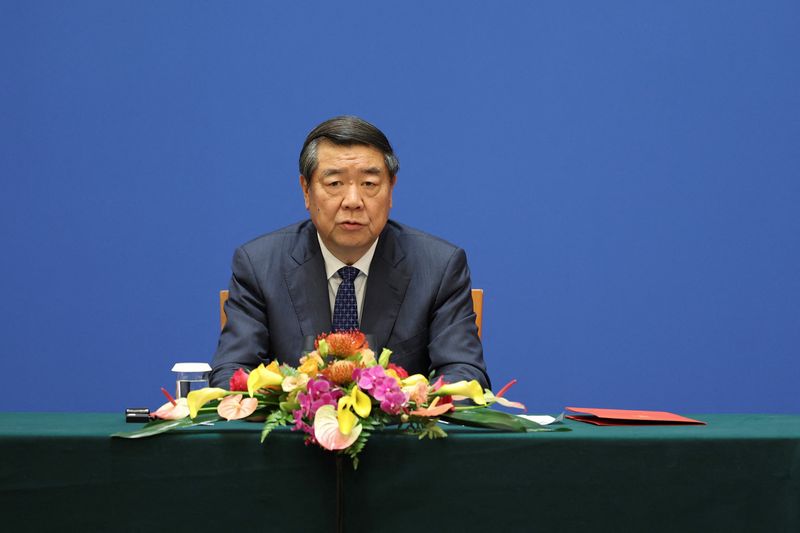
By Selena Li and Kane Wu
HONG KONG (Reuters) -Beijing told top Wall Street executives on Tuesday that it will move ahead with capital market reforms and in the opening up of its financial sector for foreigners, while supporting Hong Kong in bolstering its credentials as a global financial hub.
The pledge from Chinese policymakers at the Global Financial Leaders' Investment Summit comes amid growing geopolitical tensions following Donald Trump's election as the next U.S. president, and a destabilising slowdown in the world's second-largest economy.
"We will create an inclusive favourable business environment for outside investors and business leaders coming to China," said Zhu Hexin, deputy governor of China's central bank and administrator of the State Administration of Foreign Exchange.
"So we open our arms to foreign investors. They're welcome to the mainland to share in the success of China's economic development."
China Securities Regulatory Commission (CSRC) Chairman Wu Qing added that China would remove investment barriers and implement supporting measures while deepening capital market reforms.
Beijing will also support more high-quality enterprises from China to list and issue bonds in Hong Kong, China's Vice Premier He Lifeng said, offering backing to the city at a time when its future as a financial centre is facing scrutiny.
The summit, hosted by the Hong Kong Monetary Authority (HKMA), is being attended by the CEOs of top Wall Street firms including Citigroup (NYSE:C), Goldman Sachs and Morgan Stanley (NYSE:MS).
Hong Kong's standing as a global financial hub has been clouded in recent years after Beijing imposed a sweeping national security law in 2020. Western governments say it has hit the territory's autonomy, but Chinese authorities say it was necessary to restore order after mass pro-democracy protests in 2019.
On Tuesday, Hong Kong's High Court jailed 45 pro-democracy activists for up to 10 years following a landmark national security trial that has damaged the city's once feisty democracy movement and drawn criticism from the U.S. and other countries.
Chinese vice premier He said the country's recent stimulus measures were gradually taking effect and benefitting Hong Kong's markets. He said Beijing would help support Chinese financial institutions to expand their businesses in Hong Kong.
"We will improve the mechanism for the regular issuance of treasury bonds, steadily increase issuance in Hong Kong, and support Hong Kong in consolidating its position as a global financial business hub," He said, without providing specifics.
'BATTLING DEFLATION'
There have been $9.1 billion worth of listings in Hong Kong in 2024, according to Dealogic data, compared with $5.88 billion in 2023. Despite the pickup, issuance volumes remain well off the 2020 peak of $51.6 billion.
The deals slowdown has prompted Western and Chinese financial firms to slash hundreds of investment banking jobs in the past two years. Some international law firms have also scaled back or exited their businesses in the greater China region.
Citigroup chief executive Jane Fraser and Goldman Sachs chairman and CEO David Solomon told the forum Trump's return to the White House next year should spur more corporate buyout activity on the prospect of reduced regulation.
"When we think about deregulation tapering there (U.S), we saw an almost immediate unlock happening with the election result," Fraser said.
"... We saw a huge growth in our pipelines, almost overnight in M&A, IPOs, our sponsor clients are definitely back and I would call it "the big unlock" that we've been waiting for a long time."
In Asia, however, the deals outlook remains sluggish as China is grappling with an economic slowdown, fuelled by a property sector debt crisis and the lingering effects of the pandemic lockdowns.
Beijing unveiled earlier this month a 10 trillion yuan ($1.38 trillion) debt package to ease local government financing strains and stabilise the country's flagging growth.
Morgan Stanley CEO Ted Pick said it would take time for the stimulus measures to show effect, but early signs of recovery can be seen.
"Battling deflation takes time. And so the monetary impulse is starting to take hold, lower interest rates, more attractive mortgage rates, inducements to new ownership. The fiscal piece will take time."
Goldman's Solomon, however, said global investors who have "put a lot of capital" into China continue to be concerned about getting capital out of the country.
"And so in that context, I think messages around the ability to both attract capital and have capital come in and come out -- very, very important for global investors."
($1 = 7.2364 Chinese yuan)
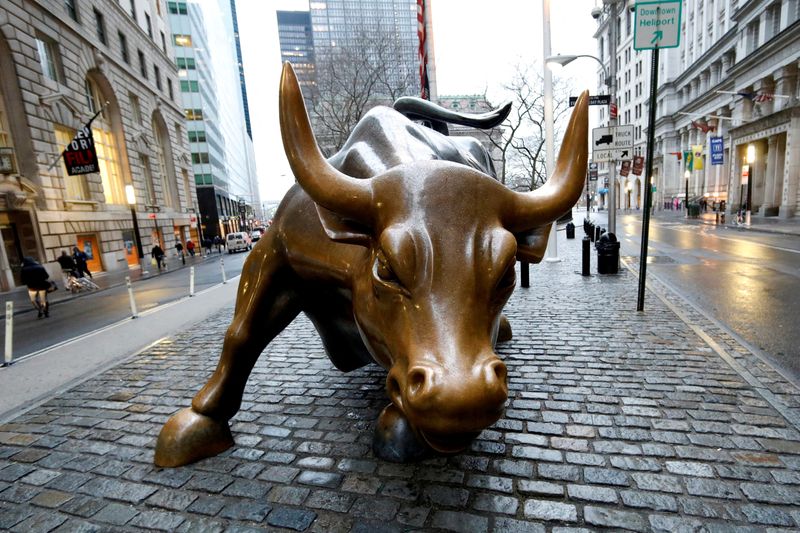
By Siddarth S
(Reuters) - Goldman Sachs has forecast the S&P 500 index would reach 6,500 by the end of 2025, joining peer Morgan Stanley (NYSE:MS), on the back of continued growth in the U.S. economy and corporate earnings.
The Wall Street brokerage's target implied an upside of 10.3% from the index's last close of 5,893.62.
On Monday, Morgan Stanley also forecast the benchmark index would hit 6,500 by the end of next year. It estimated the recent broadening in U.S. earnings growth would continue in 2025 as the Federal Reserve cuts interest rates into next year and as business cycle indicators improve further.
Goldman said the so-called 'Magnificent 7' stocks - Amazon (NASDAQ:AMZN), Apple (NASDAQ:AAPL), Alphabet (NASDAQ:GOOGL), Meta Platforms (NASDAQ:META), Microsoft (NASDAQ:MSFT), Nvidia (NASDAQ:NVDA), and Tesla (NASDAQ:TSLA) collectively will outperform the rest of the 493 companies in the benchmark index next year.
However, the 'Magnificent 7' stocks will outperform by about 7 percentage points only, the slimmest margin in seven years, Goldman said in a note dated Monday.
"Although the 'micro' earnings story supports continued outperformance of the Magnificent 7 stocks, the balance of risk from more “macro” factors such as growth and trade policy lean in favor of the S&P 493 (companies)," the brokerage said.
Goldman estimated corporate earnings to grow 11% and a real U.S. gross domestic product growth of 2.5% in 2025.
The brokerage also warned that risks remain high for the broader U.S. equity market heading into 2025, due to a potential threat from tariffs and higher bond yields.
"At the other end of the distribution, a friendlier mix of fiscal policy or a more dovish Fed present upside risks," Goldman added.
Trump's victory in the U.S. Presidential election earlier this month has brought into sharp focus his campaign pledge to lower taxes and impose higher tariffs, moves that are expected to spur inflation and reduce the Fed's scope to ease interest rates.
The brokerage also projected earnings-per-share of S&P 500 companies at $268 in 2025.
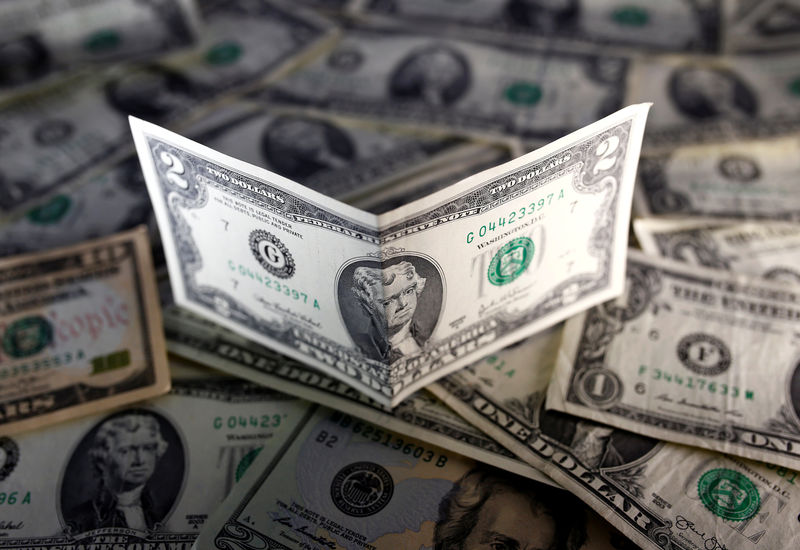
Investing.com-- Most Asian currencies firmed slightly on Tuesday, while the dollar retreated further from recent one-year highs amid persistent bets that the Federal Reserve will cut interest rates in December.
Regional markets were also bracing for more economic cues from China and Japan this week, as well as a swathe of purchasing managers index readings from major economies.
Most Asian currencies were nursing steep losses through the past week, as strong U.S. inflation readings and less dovish statements from the Federal Reserve sparked some uncertainty over just how much interest rates will fall in the coming months.
Donald Trump’s election win also saw traders pile en masse into the dollar, putting the greenback at a one-year high.
But the dollar index and dollar index futures fell 0.1% each on Tuesday, retreating further from recent peaks as markets held on to bets that rates will fall in the short-term.
Traders were seen pricing in a 59.8% chance for a 25 basis point cut in December, and a 40.2% chance rates will remain unchanged, CME Fedwatch showed.
This notion offered some relief to Asian markets, although the longer term outlook for rates still remained uncertain, especially in the face of a Trump presidency.
Chinese yuan muted as LPR decision looms
The Chinese yuan moved little on Tuesday, with the USDCNY pair remaining in sight of recent three-month highs.
Focus this week is on an interest rate decision by the People’s Bank of China, although economists expect the central bank to leave its loan prime rate unchanged on Wednesday.

SEOUL (Reuters) - South Korean President Yoon Suk Yeol has pledged a 45% increase in the country's contribution to the World Bank's International Development Association fund to more than $600 million, the finance ministry said on Tuesday.
The country, once a beneficiary during the 1960-1970s, will contribute this year around 845.6 billion won ($608.26 million) to the fund for financial aid to low-income countries, up from 584.8 billion won in the previous fund replenishment round in 2021.
"It is for South Korea to play a leading role as a global pivot state and to induce active contributions from other countries," the ministry said in a statement.
U.S. President Joe Biden on Monday pledged a record $4 billion contribution during a closed session of the Group of 20 summit in Rio de Janeiro, up from $3.5 billion in 2021.
($1 = 1,390.2000 won)

(Reuters) - U.S. homebuilder sentiment rose to a seven-month high in November and expectations for sales in the next six months surged to the highest in about two-and-a-half years after a Republican election sweep fueled optimism for regulatory changes that could lead to more residential construction, a survey said on Monday.
The National Association of Home Builders/Wells Fargo Housing Market Index rose to 46 this month, the highest since April, from 43 in October. The reading was higher than all 28 estimates in a poll of economists by Reuters, which had a median expectation for 43.
NAHB's measures of current sales and traffic of potential buyers both ticked higher, while expectations for sales over the next six months shot up to the highest since April 2022.
"With the elections now in the rear view mirror, builders are expressing increasing confidence that Republicans gaining all the levers of power in Washington will result in significant regulatory relief for the industry that will lead to the construction of more homes and apartments," said NAHB Chairman Carl Harris, a custom homebuilder from Wichita, Kansas. "This is reflected in a huge jump in builder sales expectations over the next six months."
The Nov. 5 election resulted in Republican control of the White House, with Donald Trump defeating Democrat Kamala Harris, and of both chambers of Congress. While Republicans have promised an aggressive deregulatory push, many of the rules affecting the building industry are determined at the state and local level - zoning laws in particular.

By Florence Tan
SINGAPORE (Reuters) -Oil prices edged up on Monday after fighting between Russia and Ukraine intensified over the weekend, although concerns about fuel demand in China, the world's second-largest consumer, and forecasts of a global oil surplus weighed on markets.
Brent crude futures gained 29 cents, or 0.4%, to $71.33 a barrel by 0502 GMT, while U.S. West Texas Intermediate crude futures were at $67.20 a barrel, up 18 cents, or 0.3%.
Russia unleashed its largest air strike on Ukraine in almost three months on Sunday, causing severe damage to Ukraine's power system.
In a significant reversal of Washington's policy in the Ukraine-Russia conflict, President Joe Biden's administration has allowed Ukraine to use U.S.-made weapons to strike deep into Russia, two U.S. officials and a source familiar with the decision said on Sunday.
There was no immediate response from the Kremlin, which has warned that it would see a move to loosen the limits on Ukraine's use of U.S. weapons as a major escalation.
"Biden allowing Ukraine to strike Russian forces around Kursk with long-range missiles might see a geopolitical bid come back into oil as it is an escalation of tensions there, in response to North Korean troops entering the fray," IG markets analyst Tony Sycamore said.
Saul Kavonic, an energy analyst at MST Marquee, said: "So far there has been little impact on Russian oil exports, but if Ukraine were to target more oil infrastructure that could see oil markets elevate further."
In Russia, at least three refineries have had to halt processing or cut runs due to heavy losses amid export curbs, rising crude prices and high borrowing costs, according to five industry sources.
Brent and WTI slid more than 3% last week on weak data from China and after the International Energy Agency forecasted that global oil supply will exceed demand by more than 1 million barrels per day in 2025 even if cuts remain in place from OPEC+.
China's refinery throughput fell 4.6% in October from last year and as the country's factory output growth slowed last month, government data showed on Friday.
Investors also fretted over the pace and extent of interest rate cuts by the U.S. Federal Reserve that has created uncertainty in global financial markets.
In the U.S., the number of operating oil rigs fell by one to 478 last week, the lowest since the week to July 19, Baker Hughes (NASDAQ:BKR) data showed.

Investing.com -- Tesla Inc (NASDAQ:TSLA) shares rose over 4% in after-hours trading on Robinhood (NASDAQ:HOOD) Sunday evening following reports from Bloomberg that the upcoming Trump administration will establish a federal framework for fully self-driving vehicles and make it a top priority for the Department of Transportation.
The development is seen as a major boon for Tesla, which has been leading the charge for fully autonomous driving. CEO Elon Musk has been a major supporter of President-elect Donald Trump and is now considered in his inner circle. Musk and Vivek Ramaswamy are heading up the recently announced Department of Government Efficiency (DOGE), which was tasked with cutting government spending waste.
The Trump administration is seeking leaders to develop the department’s framework for regulating self-driving vehicles. Current federal rules significantly restrict cars without foot pedals and steering wheels. Former Uber (NYSE:UBER) executive Emil Michael is said to be one of the candidates under consideration to lead the department. Republican Representatives Sam Graves and Garrett Graves are also said to have been considered.
Telsa recently announced plans to launch a Robotaxi service in 2026. Current regulations could limit the potential service. However, Musk’s influence in the new Trump administration could lay the groundwork for mass deployment and success of the new Tesla service.
Tesla shares have been up 28% since Trump won the election on November 5th.

By Gloria Dickie
BAKU (Reuters) -The world's warming tropical wetlands are releasing more methane than ever before, research shows — an alarming sign that the world's climate goals are slipping further out of reach.
A massive surge in wetlands methane — unaccounted for by national emissions plans and undercounted in scientific models — could raise the pressure on governments to make deeper cuts from their fossil fuel and agriculture industries, according to researchers.
Wetlands hold huge stores of carbon in the form of dead plant matter that is slowly broken down by soil microbes. Rising temperatures are like hitting the accelerator on that process, speeding up the biological interactions that produce methane. Heavy rains, meanwhile, trigger flooding that causes wetlands to expand.
Scientists had long projected wetland methane emissions would rise as the climate warmed, but from 2020 to 2022, air samples showed the highest methane concentrations in the atmosphere since reliable measurements began in the 1980s.
Four studies published in recent months say that tropical wetlands are the likeliest culprit for the spike, with tropical regions contributing more than 7 million tonnes to the methane surge over the last few years.
"Methane concentrations are not just rising, but rising faster in the last five years than any time in the instrument record," said Stanford University environmental scientist Rob Jackson, who chairs the group that publishes the five-year Global Methane Budget, last released in September.
Satellite instruments revealed the tropics as the source of a large increase. Scientists further analyzed distinct chemical signatures in the methane to determine whether it came from fossil fuels or a natural source — in this case, wetlands.
The Congo, Southeast Asia and the Amazon (NASDAQ:AMZN) and southern Brazil contributed the most to the spike in the tropics, researchers found.
Data published in March 2023 in Nature Climate Change shows that annual wetland emissions over the past two decades were about 500,000 tonnes per year higher than what scientists had projected under worst-case climate scenarios.
Capturing emissions from wetlands is challenging with current technologies.
"We should probably be a bit more worried than we are," said climate scientist Drew Shindell at Duke University.
The La Nina climate pattern that delivers heavier rains to parts of the tropics appeared somewhat to blame for the surge, according to one study published in September in the journal Proceedings of the National Academy of Sciences.
But La Nina alone, which last ended in 2023, cannot explain record-high emissions, Shindell said.
For countries trying to tackle climate change, "this has major implications when planning for methane and carbon dioxide emissions cuts," said Zhen Qu, an atmospheric chemist at North Carolina State University who led the study on La Nina impacts.
If wetland methane emissions continue to rise, scientists say governments will need to take stronger action to hold warming at 1.5 C (2.7 F), as agreed in the United Nations Paris climate accord.
WATER WORLD
Methane is 80 times more powerful than carbon dioxide (CO2) at trapping heat over a timespan of 20 years, and accounts for about one-third of the 1.3 degrees Celsius (2.3 F) in warming that the world has registered since 1850. Unlike CO2, however, methane washes out of the atmosphere after about a decade, so it has less of a long-term impact.
More than 150 countries have pledged to deliver 30% cuts from 2020 levels by 2030, tackling leaky oil and gas infrastructure.
But scientists have not yet observed a slowdown, even as technologies to detect methane leaks have improved. Methane emissions from fossil fuels have remained around a record high of 120 million tonnes since 2019, according to the International Energy Agency's 2024 Global Methane Tracker report.
Satellites have also picked up more than 1,000 large methane plumes from oil and gas operations over the past two years, according to a U.N. Environment Programme report published on Friday, but the countries notified responded to just 12 leaks.
Some countries have announced ambitious plans for cutting methane.
China last year said it would strive to curb flaring, or burning off emissions at oil and gas wells.
President Joe Biden's administration finalized a methane fee for big oil and gas producers last week, but it is likely to be scrapped by the incoming presidency of Donald Trump.
The Democratic Republic of Congo's environment minister Eve Bazaiba told Reuters on the sidelines of the U.N. climate summit COP29 that the country was working to assess the methane surging from the Congo Basin's swampy forests and wetlands. Congo was the largest hotspot of methane emissions in the tropics in the 2024 methane budget report.
"We don't know how much [methane is coming off our wetlands]," she said. "That's why we bring in those who can invest in this way, also to do the monitoring to do the inventory, how much we have, how we can also exploit them."
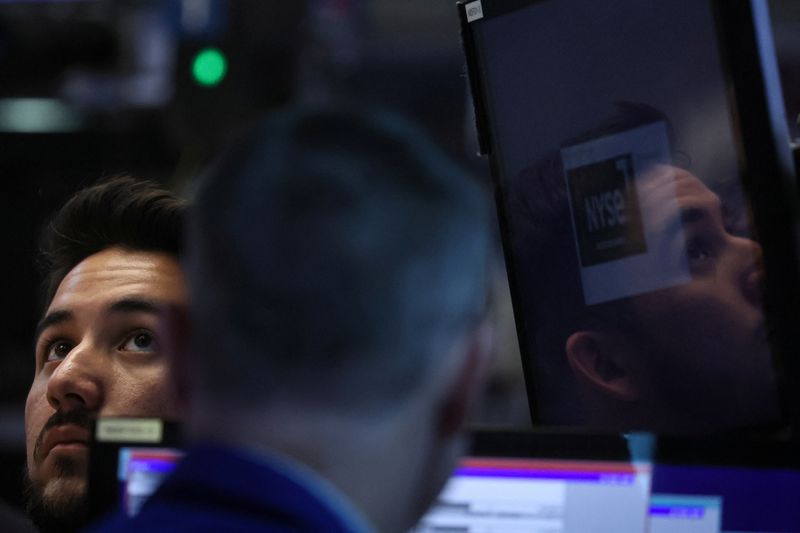
Investing.com -- AI darling Nvidia is reporting quarterly results, the crypto rally rolls on, the UK is to release inflation data and oil prices look set to remain on the back foot. Here's your look at what's happening in markets for the week ahead.
1. Nvidia results
Chipmaker Nvidia (NASDAQ:NVDA), a bellwether for the AI craze that has boosted stocks this year is due to report third quarter earnings after the close on Wednesday.
The results could well be a gauge for investors’ appetite for tech stocks, the AI trade and sentiment for equities broadly, after a post-election market rally stalled.
Nvidia’s chips are seen as the gold standard in the AI-space and its shares have risen around 200% this year, overtaking Apple (NASDAQ:AAPL) to become the world's largest company by market capitalization. Its outsize weighting in the S&P 500 has helped power the index to record highs this year.
Investor expectations are high going into earnings, raising the chances for short term volatility.
Last week analysts at Raymond James raised their Nvidia price target from $140 to $170 and reiterated that “any pullback due to high expectations [is] an opportunity.”
2. Crypto rally
Bitcoin’s price has surged 30% since the Nov. 5 U.S. election, rising above the $90,000 level for the first time, amid a rally that shows no signs of stopping.
The entire cryptocurrency market cap has risen above $3 trillion in value for the first time ever, which means that Bitcoin and other digital assets are currently worth as much as the combined market cap of Elon Musk's Tesla (NASDAQ:TSLA), Facebook (NASDAQ:META) parent Meta and Warren Buffett's Berkshire Hathaway (NYSE:BRKa).
The rally is being driven by expectations of a more favorable regulatory environment under the Trump administration and with momentum continuing to build, some analysts see a six-figure bitcoin price as increasingly likely.
A one-time crypto skeptic, President-elect Donald Trump has pledged to set up a national Bitcoin reserve and make the U.S. a global hub for the industry but it remains to be seen how feasible his promises are and what the timeline will be for their implementation.
3. U.S. data, Fedspeak
The U.S. economic calendar is quieter in the week ahead, but investors will get updates on the health of the housing sector, with reports on building permits, housing starts and existing home sales.
The calendar also includes the weekly report on weekly jobless claims, while manufacturing and service sector PMI data on Friday could give early indications on how companies are reacting to the threat of Trump's proposed trade tariffs - a data point that will be closely watched by markets from here on.
Elsewhere, earnings results from Walmart (NYSE:WMT) and Lowe’s (NYSE:LOW) on Tuesday will give fresh insights into the strength of consumer spending.
Investors will also get the chance to hear from several Federal Reserve officials, including Chicago Fed President Austan Goolsbee, Kansas Fed President Jeffrey Schmid and Cleveland Fed President Beth Hammack.
4. Oil prices
Oil prices ended around 2% lower on Friday, adding to losses for the week as a combination of fears over weakening demand from China and the prospect of a slower pace of Fed rates cuts weighed.
For the week, Brent fell around 4%, while crude futures declined around 5%.
Data on Friday showed that Chinese refineries processed less crude in October on a year-over-year basis as domestic demand slowed, adding to fears over the economic outlook of the world's largest crude importer.
Earlier in the week, the International Energy Agency forecast that global oil demand will slow, leading to an oil surplus in 2025.
Meanwhile, Fed Chair Jerome Powell indicated Thursday the central bank can afford to be careful with the future pace and scope of rate cuts, citing ongoing economic growth, a solid job market, and inflation above the Fed’s 2% target.
Lower interest rates typically spur economic growth, aiding fuel demand.
5. UK inflation
The UK is to release October CPI data on Wednesday with economists expecting the annual rate of inflation to have risen 2.2%, climbing back above the Bank of England’s 2% target.
That would be an increase from 1.7% in September, the first time the annual rate of inflation dropped below the BoE’s target in more than three years.
The BoE delivered a second 25-basis point rate cut earlier this month and said further cuts were likely to be gradual as it assessed the persistence of inflation pressures including from the first budget of Britain's new government.
BoE Governor Andrew Baily along with several other officials will appear before Parliament's Treasury Committee on Tuesday to answer questions on inflation and the monetary policy outlook.
The UK is to release October retail sales data on Friday along with manufacturing and service sector PMI data.
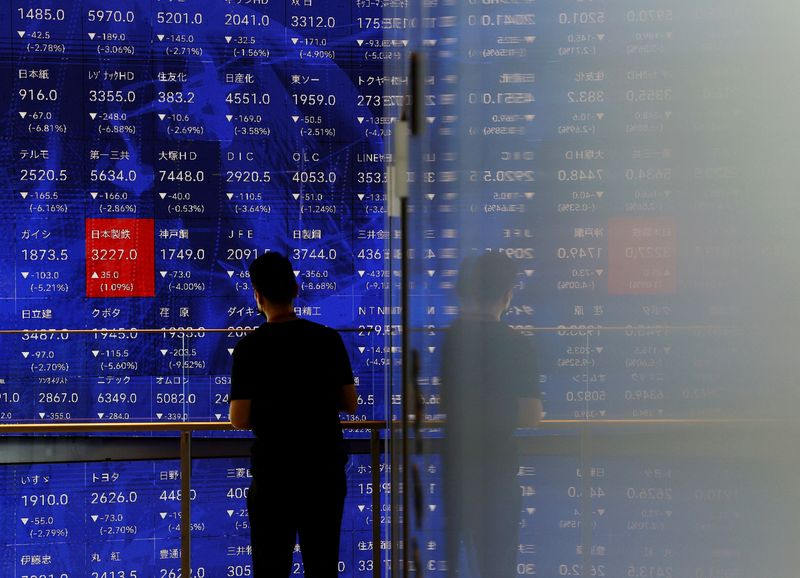
(Reuters) - Foreigners sold off most Asia ex-China bond markets in October as they were cautious ahead of the U.S. presidential election.
The potential for a Donald Trump victory, which ended up being the actual result, raised concerns of increased inflation from his planned tariffs and tax cuts, which lowered expectations for the accelerated rate cuts that had supported regional bonds this year.
They sold local bonds in Malaysia, Thailand and India, totalling a net $3.8 billion, following five monthly net purchases in a row, according to data from regulatory authorities and bond market associations.
Trump's decisive victory in last week's election has led analysts to adopt a more pessimistic view of foreign investment flows into Asian bonds.
Eugene Leow, senior rates strategist at DBS Bank, said a stronger dollar and rising Treasury yields, fuelled by increased bets on Trump-related trades, have been exerting pressure on Asian government bonds and interest rates.
"Optimism that was initially sparked by Fed easing bets around the middle of the year have largely evaporated," he said.
"Against this challenging backdrop, scope for Asia central bank easing has become more restrained while investor sentiment on local currency bonds have also become more muted."
The U.S. dollar was poised for big weekly gains on Friday, towering near one-year highs as a hawkish turn from the Federal Reserve chief sent short-term Treasury yields higher.
On the other hand, foreigners pumped $4.03 billion into South Korean bonds last month on optimism over South Korea's inclusion in the FTSE Russell's World Government Bond Index (WGBI) starting November 2025.
Indonesian bonds also received about $1.5 billion, a sixth monthly foreign inflow in a row.

